A dislocated shoulder is a common injury that can cause severe pain and discomfort and limit your range of motion. The shoulder is a ball-and-socket joint. Shoulder joint dislocation happens when the upper arm bone (which is shaped like a ball) comes out of the shoulder socket. It can be caused by different things, like injuries from sports, accidents, or doing the same motion over and over again.
In the United States, there are about 24 cases of shoulder dislocations per 100,000 people each year. This is more common in men than women and usually happens to men between the ages of 20 and 30. For women, it's more common in those aged 61–80.
If you've experienced a dislocated shoulder, you know how debilitating it can be. However, you can take steps to relieve pain and promote healing.
How Do I Ease The Pain Of A Dislocation?
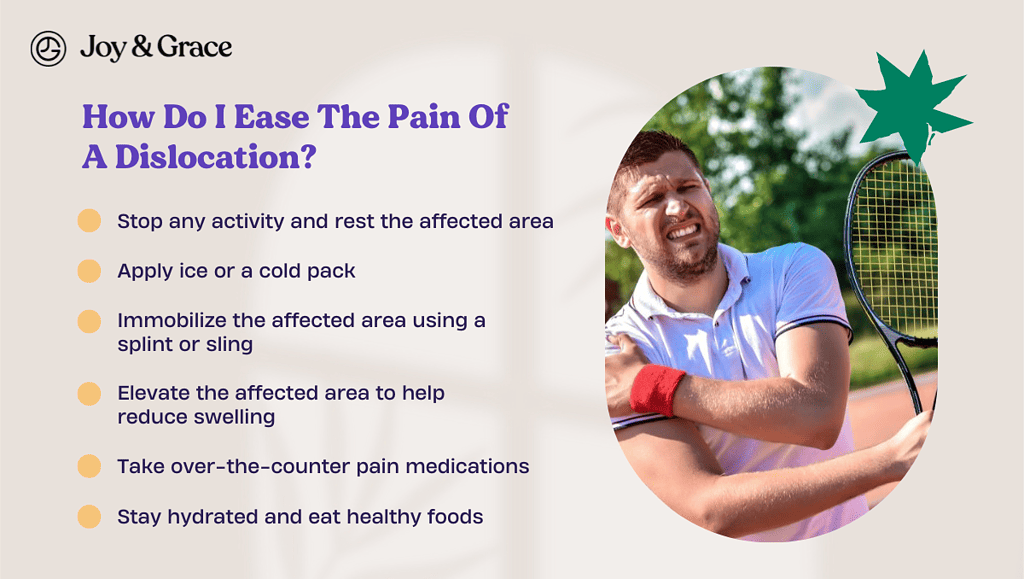
It's important to note that shoulder dislocation is a serious injury. It should be evaluated by a medical professional as soon as possible.
However, if you're unable to seek medical attention immediately, here are some steps you can take to ease the pain of a dislocation at home:
- Stop any activity and rest the affected area.
- Apply ice or a cold pack to the area for 20 minutes at a time, several times a day, to reduce swelling and numb the area.
- Immobilize the affected area using a splint or sling to keep it from moving. (A general recommendation for shoulder dislocations in people over 30 years old is to keep the joint immobilized for around one week).
- Elevate the affected area to help reduce swelling.
- Take over-the-counter pain medications such as acetaminophen or ibuprofen to help relieve shoulder pain.
- Stay hydrated and eat healthy foods to help your body heal faster.
Will Muscle Relaxers Help A Dislocated Shoulder?
Muscle relaxers may be prescribed to help ease muscle spasms and tension that may occur after a dislocated shoulder.
However, they are not typically the first line of treatment for a dislocated shoulder.
What Is The First Aid Treatment For Dislocation?
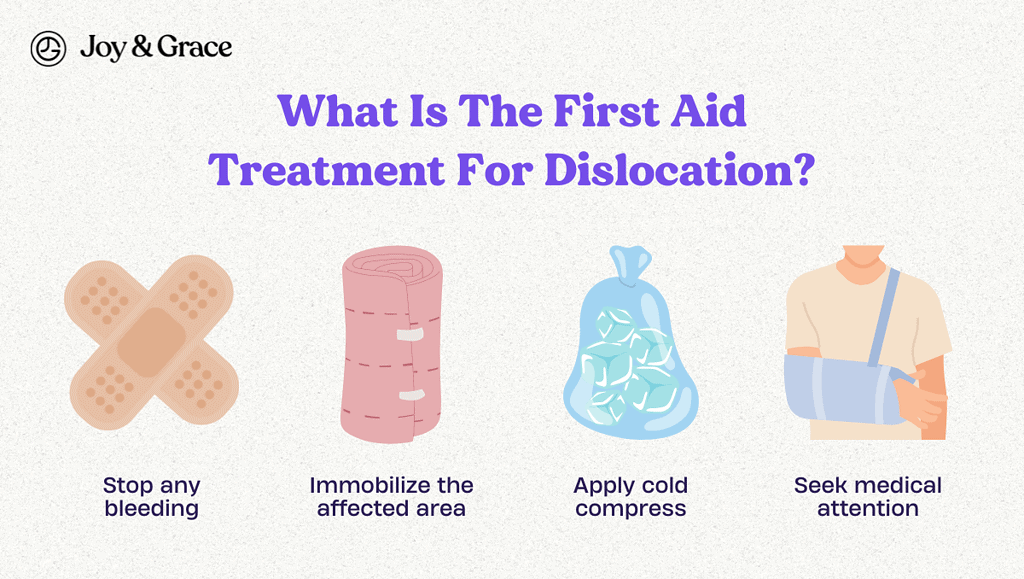
Here are the steps to take for first aid treatment for shoulder dislocation:
- Stop any bleeding
If there is bleeding, apply pressure to the wound using a clean cloth or sterile dressing.
- Immobilize the affected area.
Refrain from attempting to put the joint back in place. Instead, keep the affected area immobilized to prevent further damage. You can use a shoulder immobilizer, like a splint or a sling, to keep the site still.
- Apply cold compress
Apply a cold compress to the affected area to reduce swelling and pain.
- Seek medical attention
Dislocations require medical attention. Call for an ambulance or go to the nearest hospital emergency department.
Should I Ice Or Heat A Dislocated Shoulder?
You can apply ice to the area to help reduce pain and swelling. Ice can also help reduce inflammation, which can be beneficial for healing.
After dislocating your shoulder, avoid using heat immediately. Heat can make the pain and swelling worse by increasing blood flow.
Once your shoulder is no longer painful or swollen, you may be advised to use heat therapy. Heath therapy can relax your shoulder muscles and improve your range of motion.
As always, it's important to follow the advice of your doctor or physical therapist when it comes to treating injuries.
What Does The Pain Of A Dislocated Shoulder Feel Like?
The pain of a dislocated shoulder can vary in intensity and type, but it is generally described as sudden and severe. The pain may be accompanied by other symptoms, such as:
- Swelling and stiffness in the shoulder joint
- Limited range of motion in the shoulder
- Numbness or tingling in the arm or hand
- A popping or tearing sensation when the injury occurs
The pain may be felt in the shoulder joint and surrounding areas, such as the upper arm, neck, or back. In addition to the intense pain, some people may also experience muscle spasms or cramping in the shoulder area.
Why Is A Dislocated Shoulder So Painful?
A dislocated shoulder is a painful injury because it involves the separation of the upper arm bone from the socket in the shoulder blade. The pain is typically caused by the stretched or torn ligaments, tendons, and other connective tissues surrounding the joint. In severe cases, there might even be bone fractures present.
Additionally, when the upper arm bone is dislocated, it can compress nerves and blood vessels, which can cause:
- Numbness
- Tingling
- Decreased blood flow to the arm
What Is The Fastest Way To Heal A Dislocated Shoulder?

The quickest way to recover from a dislocated shoulder is to seek medical treatment immediately.
In many cases, a doctor (such as an orthopedic surgeon) can reset the joint back into place. This usually provides immediate relief and promotes faster healing.
After the shoulder has been put back into place, the following may help promote healing and prevent further injury:
- Physical therapy
Your doctor may recommend physical therapy to help you regain strength and range of motion in your shoulder after it has healed.
- Surgery
In some cases, surgery may be necessary to repair joint damage or prevent future shoulder dislocations.
Will I Need Surgery For My Dislocated Shoulder?
Whether or not you will need surgery for a dislocated shoulder depends on various factors. This includes:
- The severity of the dislocation
- The amount of damage to the surrounding connective and soft tissues
- If the dislocation is happening for the first time, or if it is a recurring injury
- Age, overall health, and medical history.
Most of the time, conservative treatments can help you heal and get back to normal function, especially if it is a first-time dislocation. But if the dislocation is severe or recurring, surgery may be necessary. Surgery can repair the damaged tissues and bring back proper shoulder stability.
According to one study, if you are younger than 25 years old, it's likely that the joint will dislocate again if you don't have surgery.
The same study additionally notes that if you have repeated dislocations, you are at a higher risk of developing arthritis in that joint.
All things considered, surgery is an excellent treatment option to reduce the risk of recurrent dislocations and the development of arthritis in the long term.
If you need surgery and delay it, the surgery may become more complex, as the damage to your joint can worsen. Surgical repair, when needed, is usually recommended to be performed within 10 days.
What Are The Types Of Surgery For A Dislocated Shoulder?
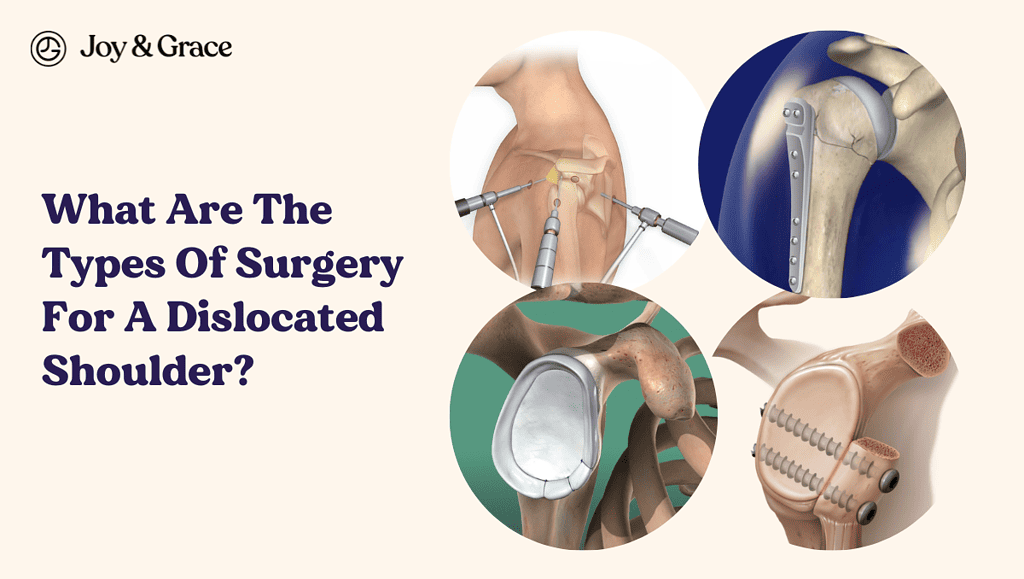
Several types of surgery may be performed for a dislocated shoulder, depending on the specific nature and extent of the injury. Some common surgical procedures include:
- Arthroscopic surgery
This minimally invasive procedure involves the insertion of a small camera and instruments into the shoulder joint to repair damaged tissues or remove loose bone fragments.
- Open reduction and internal fixation (ORIF)
This procedure involves making an incision to realign the bones of the shoulder joint. Then screws, pins, or other hardware are used to hold them in place while they heal.
- Bankart repair
This procedure is specifically designed to repair a tear in the labrum that can occur with a dislocation. The labrum is a ring of cartilage that surrounds the joint capsule. It involves reattaching the torn labrum to the bone using sutures or anchors.
According to a study, the Bankart procedure significantly improves shoulder function. It also reduced pain and the likelihood of recurrent dislocation. Patients in the study reported better shoulder range of motion and reduced shoulder joint symptoms.
- Latarjet procedure
This procedure involves taking a piece of bone from another part of the body (usually the shoulder blade). The bone is then used to create a new socket for the upper arm bone, which can help prevent future dislocations.
In one study, patients who underwent the Latarjet procedure had an improved range of motion after the procedure. They also had a lesser chance of developing shoulder arthritis.
How Do I Sleep With A Dislocated Shoulder?
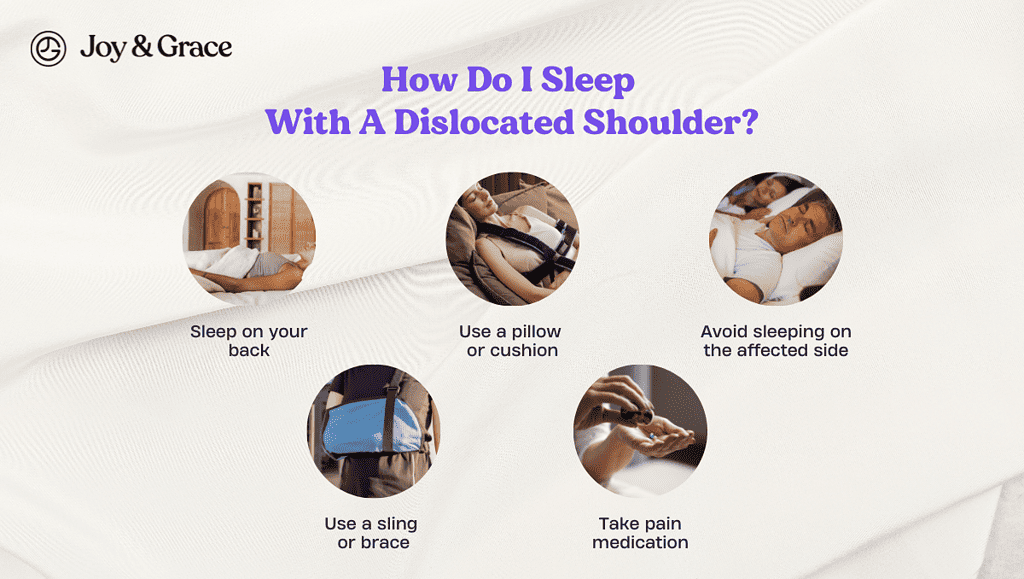
Sleeping with a dislocated shoulder can be challenging. Lying in certain positions can be uncomfortable and even painful. Here are some tips that may help:
- Sleep on your back
Sleeping on your back can help keep your shoulder in a neutral position and reduce the risk of further injury. Use a supportive pillow to help keep your head and neck aligned with your spine.
- Use a pillow or cushion
If you find lying flat on your back uncomfortable, try propping up the upper body with a pillow or cushion. This can help reduce pressure on the affected shoulder and provide some relief.
- Avoid sleeping on the affected side
Sleeping on the side with the dislocated shoulder can be painful and may cause further injury. Avoid this position until the shoulder has healed.
- Use a sling or brace
Your health care provider may recommend using a sling or brace to immobilize the shoulder while you sleep. This can help keep the shoulder stable and reduce pain.
- Take pain medication
If you are experiencing severe pain while trying to sleep, you can ask your doctor to prescribe painkiller drugs.
Can I Take My Arm Sling Off When I Go to Sleep?
To sling or not to sling while you sleep, that is the question! Generally, it is important to follow your health care provider’s instructions for wearing a sling. This may include wearing it while you sleep.
Some credible sources say that, during the first one to three weeks of immobilization, the sling should not be taken off even when you go to sleep. The same source says that the sling can only be removed when:
- You’re bathing,
- Slightly moving (mobilizing) the elbow and wrist, or
- Doing Codman exercises
A sling can help support the weight of your arm and immobilize your shoulder, reducing pain and promoting healing. Wearing a sling while you sleep can also help prevent unintentional movements. Those include rolling onto your affected shoulder during the night, for example. Avoiding these is important as they increase the risk of reinjuring the shoulder.
However, if your healthcare provider says it's okay, you can break free from the sling and enjoy the sweet freedom of sleeping without it. Remember, always follow their medical advice to a tee and make sure it's safe to give your sling the boot. We don't want any nighttime accidents that could prolong your recovery.
What Should I Not Do After Shoulder Dislocation?
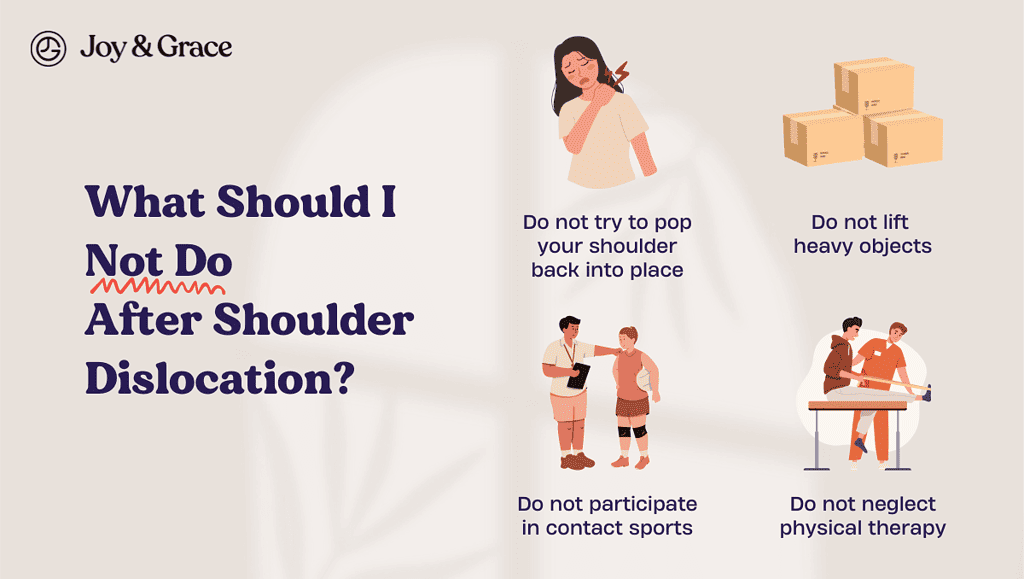
You should avoid doing certain things to prevent further shoulder injury and promote healing. Here are some things you should not do after a shoulder dislocation:
- Do not try to pop your shoulder back into place
You should not attempt to put your shoulder back into place on your own. Doing that can cause further damage to the surrounding muscles, tendons, and ligaments.
- Do not lift heavy objects
Heavy lifting can put undue stress on your shoulder, which can cause further damage or re-injury.
- Do not participate in contact sports or activities that involve overhead movements
Physical activities that require repetitive overhead movements can increase your risk of re-dislocating your shoulder. They may also end up causing additional damage.
- Do not neglect physical therapy
Your doctor or physical therapist will likely recommend specific exercises to help you regain strength and mobility in your shoulder. Neglecting these exercises can delay your recovery or lead to long-term complications.
How Do I Rehab A Dislocated Shoulder?
The best way to rehab your dislocated shoulder is by closely working with your physical therapist.
Only a physical therapist can adequately assist and closely guide the rehabilitation process.
That said, there are a few exercises you can safely do on your own. Here are some of them:
- Isometric Shoulder Flexion:
- Stand in front of a wall.
- Make a fist and bend the elbow of the shoulder you want to work out.
- Put a folded towel between your fist and the wall and gently press your hand into the wall.
- Hold it for five seconds, then let go slowly.
- Do 10 to 15 reps
You don't need to try to knock down the wall. The goal is to just gently press against it to get activate your shoulder muscles.
If it hurts, you should stop.
- Isometric Shoulder Abduction
- Stand about six inches from a wall, and turn your body so that it is perpendicular to the wall.
- Get the shoulder you want to work out with close to the wall. You might want to put a folded-up towel between your fist and the wall for a little more comfort.
- Make a fist and gently push against the wall with it. Hold the push for about five seconds.
- Slowly take your hands off the wall.
- Perform 10 to 15 repetitions.
- Isometric Shoulder External Rotation
- Keep standing about six inches from a wall and facing it straight on.
- Similarly to the previous exercise, get the shoulder you want to work out with close to the wall. If you need a little cushion, use a small towel.
- Bend your elbow 90 degrees, make a fist, and press the back of your hand against the wall as if you were turning your arm outwards.
- Press softly against the wall for about 5 seconds.
- Slowly take your hands off the wall.
- Do 10 to 15 reps.
- Isometric Shoulder Internal Rotation
- Face a door frame or an outside of a corner of a wall. The shoulder you are working out should be close to the doorway or the corner.
- Bend your elbow 90 degrees, make a fist, and gently press into the corner wall or door jamb as if trying to turn your hand toward your belly button.
- Press and hold for five seconds, then slowly let go.
- Shoulder Blade Squeezes
- Squeeze your shoulder blades together as you stand with your arms at your sides. Try to avoid raising your shoulders while you squeeze.
- Maintain for 6 seconds.
- Repeat ten to twelve times.
How Long Does It Take For A Dislocated Shoulder To Stop Hurting?
While the sling may no longer be needed after a few days or a week, it can take much longer for the shoulder to fully recover. The recovery process can take anywhere from 12 to 16 weeks, during which the shoulder needs time to heal and strengthen.
During the initial two weeks after the dislocation, you may be able to resume most everyday activities. Still, avoiding heavy lifting or activities involving shoulder movements is important.
After this initial period of time, you may gradually resume your normal activities. But avoiding heavy lifting and sports involving shoulder movements for between 6 weeks to 3 months is recommended.
If you’re into sports, you may want to pay attention to this. Researchers examined data from 50 basketball players who injured their shoulders while playing in the NBA. Players with shoulder dislocation were found to take longer to recover and return to playing than those with other injuries.
Will My Shoulder Ever Be The Same After Dislocation?
The answer to this question depends on a variety of factors, including:
- The severity of your dislocation
- The treatment you receive
- Your commitment to rehabilitation.
Most of the time, a dislocated shoulder without any other complication can fully heal with proper conservative medical care and rehabilitation.
However, in other cases, there may be long-term effects or complications.
What Are The Long-Term Effects Of A Dislocated Shoulder?
Some possible long-term effects of a dislocated shoulder include the following:
- Recurring dislocations
In some cases, a dislocated shoulder can lead to long-term instability in the joint. This can increase the risk of future recurrent dislocations.
- Instability
After a dislocation, the ligaments and tendons that support the shoulder joint can become stretched or torn. A classic example is rotator cuff tears, which are reported to occur in over half of patients over 40 years old. That may lead to instability in the joint, which can cause ongoing pain, weakness, and limited mobility.
- Arthritis
A dislocated shoulder can cause damage to the cartilage in the joint, increasing the risk of developing arthritis over time. This can lead to ongoing pain and stiffness in the joint.
A study followed patients for an average of 15 years after their first shoulder dislocation to see how many developed osteoarthritis. About 25% of patients developed osteoarthritis after experiencing shoulder dislocation.
- Limited mobility
In some cases, a dislocated shoulder can result in limited mobility or range of motion in the affected shoulder.
- Muscle weakness
After a dislocation, the muscles in the shoulder can shrink and become weak. This may lead to ongoing shoulder weakness and reduced function.
Can I Get Nerve Damage From A Dislocated Shoulder?
Simple dislocations don't involve other bone, nerve, vessel, or rotator cuff injuries.
However, complex dislocations can include injuries to these tissues, which can result in nerve damage. Nerve damage is a well-known complication of shoulder dislocations. The axillary nerve is the most commonly (and severely) affected.
Shoulder dislocations can also lead to brachial plexus injuries. This can range from temporary weakness or tingling to permanent paralysis of the limb. According to a study, neurological complications occur in 5.4% to 55% of all dislocations. Older women and young men are the most commonly affected groups.
However, according to the same study, most brachial plexus injuries luckily resolve spontaneously. Even though surgery may still be necessary in 13% to 18% of cases.
In this case report, a 55-year-old woman came to the emergency department with a dislocated shoulder after a violent sneeze (we’re shocked, too). Although her injury was not severe, it caused significant nerve damage.
Doctors were able to put her shoulder back into place, and she gradually regained most of the function in her arm over the course of a year. However, she still had a little weakness in her arm.
Takeaway
While a dislocated shoulder can be a painful injury, there are several methods for managing pain and promoting healing.
Some simple strategies include applying ice or heat therapy and taking pain medication. Performing gentle exercises is also recommended. By following these tips, you can help ease your discomfort and get back to your normal activities sooner.















